Farmers have again locked horns with the Centre over demand for MSP for their crops, writes Aayush Goel
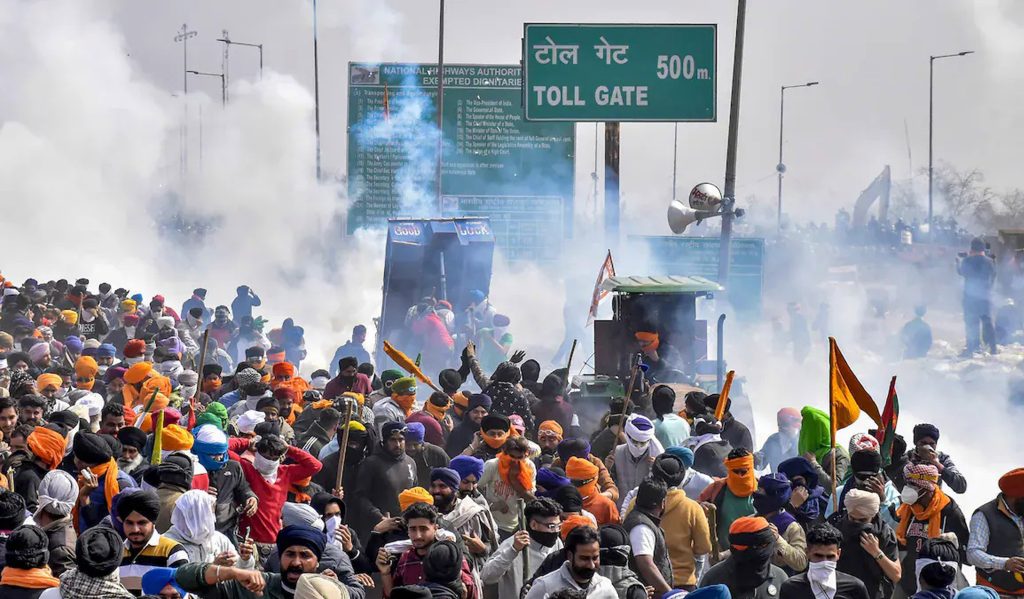
After a period of thaw lasting for almost two years, the Indian farmer movement seeking MSP for their crops has been revived. Started on February 13 with Dilli Chalo 2.0, the movement is now epicentered around Punjab-Haryana borders. Visuals of clashes between farmers and Haryana police with the latter stopping them from entering into their state en-route to Delhi, using tear gas, pellets and stones are going viral across the world while the current regime dismisses the movement as a politically motivated stint ahead of Lok Sabha elections.
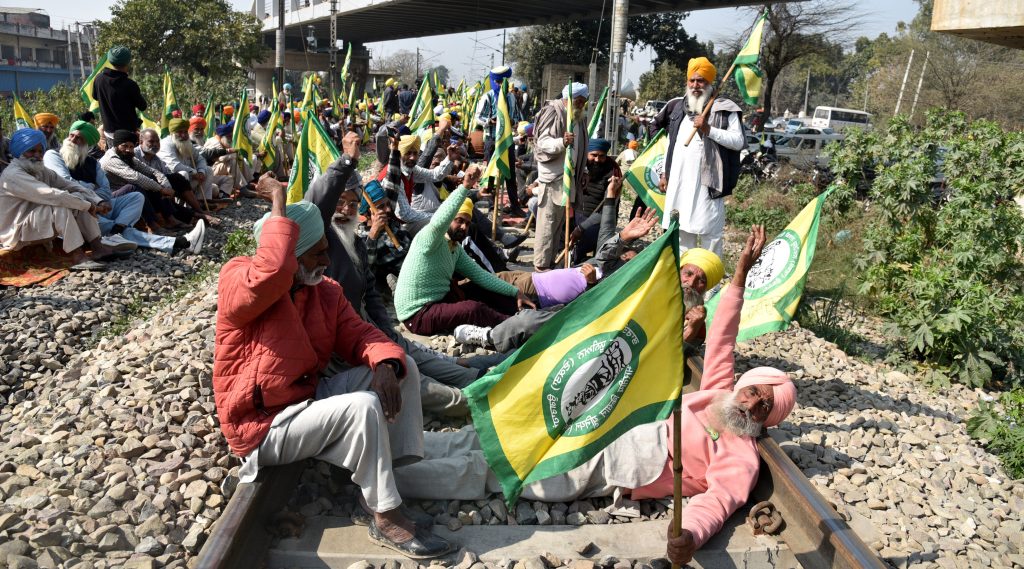
On February 13, groups of farmers responded to a call given by the Kisan Mazdoor Morcha and the Samyukta Kisan Morcha (non-political) and began a march to the national capital, to press for fulfilment of their demands. While farmers from different states reportedly started heading for Delhi, it has been largely from Punjab that scores of farmers started their ‘tractor-trolley’ march to reach Delhi via Haryana. As they arrived at Shambhu-Ambala and Khanauri-Jind borders, both on the inter-state boundary between Haryana-Punjab, they were stopped from entering Haryana.
The Haryana government had put in place elaborate security arrangements with multi-layer barricades, which included iron nails, barbed wires, concrete barricade-blocks, boulders, trenches and anti-riot vehicles on the roads bordering Punjab. Ready for the same as farmers went ahead smashing the barricades, the police resorted to the use of tear gas through drones, and water cannons to disperse the agitating farmers. The internet was suspended for over a week in Haryana districts bordering Punjab. Meanwhile, massive deployment of police and paramilitary personnel was done in areas bordering Delhi to stop protesting farmers from entering the city.
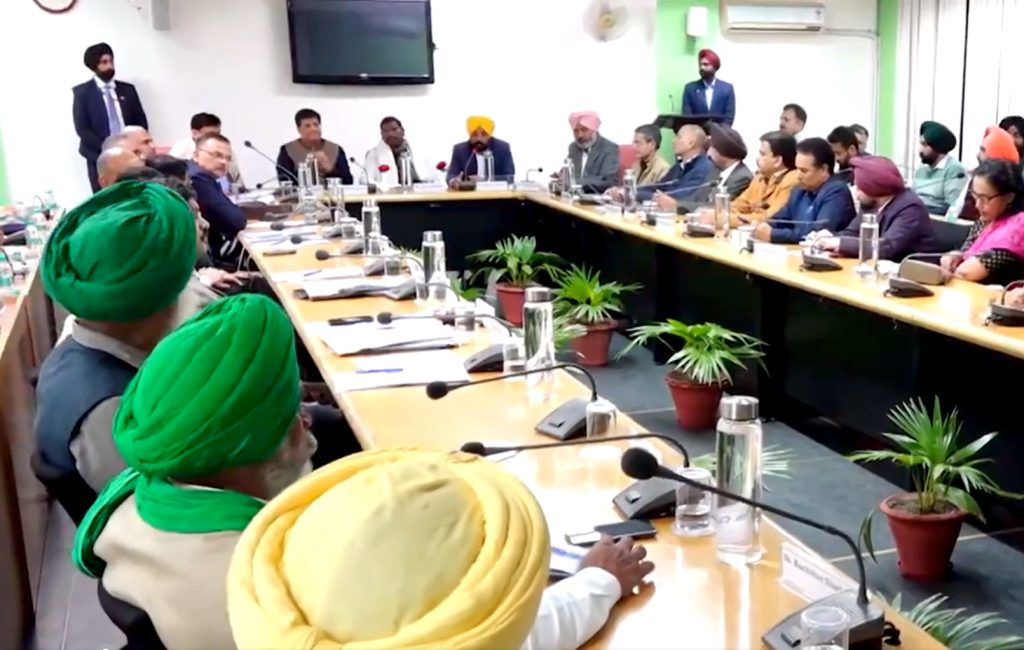
So far, seven lives have perished in the stand-off including five farmers. The two cops died of cardiac attacks while posted on duty. Similarly, according to official records from Patiala’s Rajindra Hospital, three farmers too passed away due to heart attacks. Subhkaran Singh from Punjab’s Baloke village died in a clash between security forces and protesting farmers at Khanauri border. The farmers allege he was shot but with no post-mortem till date being allowed by family and protestors, the claim is yet to be verified.
The farmers claim that over 150 people have so far been injured by pellets and shells while Haryana police peg the number of injured cops at 30. The stand-off still continues after two failed attempts by farmers to reach Delhi. Though now they have deferred the march till February 29, they have been camping near different locations on the inter-state boundary with Haryana.
This has thrown the traffic on Delhi-Chandigarh highway out of gear with the vehicles being diverted via Indri and Yamunanagar for many days. The farmers have accused the BJP-led Haryana government of deep hostility towards them and their cause even as they asserted that holding a peaceful protest was their fundamental right.
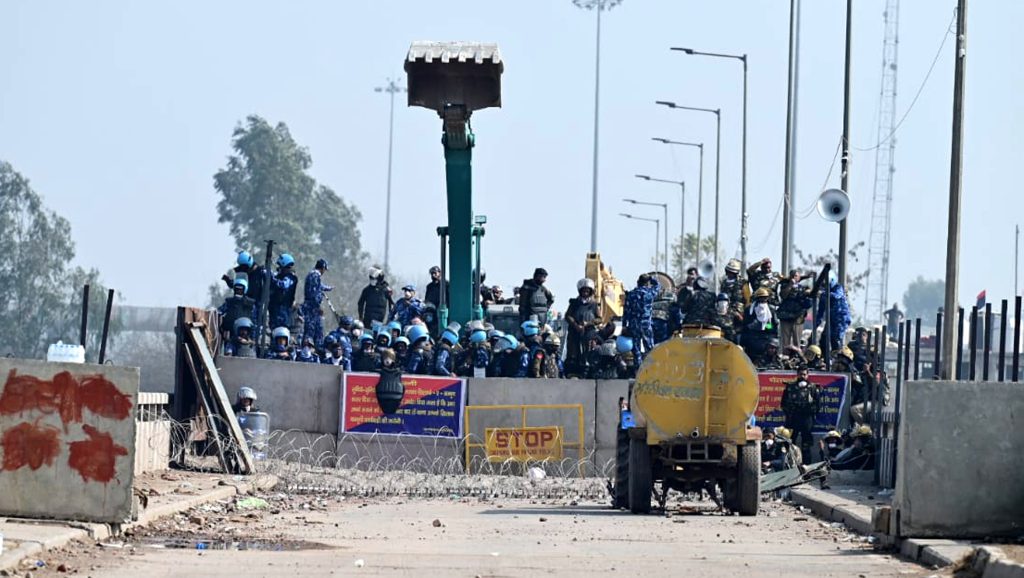
“Haryana, a BJP-ruled state, is a puppet in the hands of the central government. They are treating us not like farmers but mobsters or rioters. We have a fundamental right to protest and holding no ill will announced our march to help states prepare for traffic management. They however prepared for war. They erected barricades on highways and got war level stock of drones, expired tear gas shells and rubber pellets and waged a war. We believed in the government once and gave it two years, but we were fooled. However, we will not be taken in by their hollow promises now,” says Jagjit Singh Dallewal, farmer leader and president of Bhartiya Kisan Union Ekta Sidhupur.
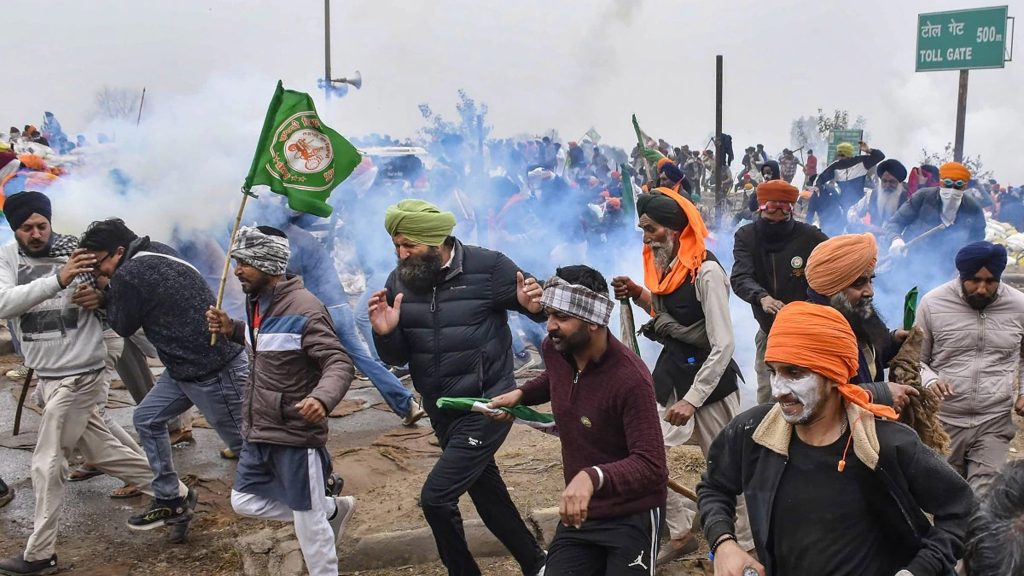
Duped by Centre: Farmers
According to Sarvan Singh Pandher, who heads Kisan Mazdoor Sangharsh Committee (KMSC), the script for Dilli Challo 2.0 was written by the Modi government itself when it made false promises and sent farmers home from the Singhu border in 2021. In December 2021, the farmers decided to return home after the three farm laws they had protested against for nearly two years were rescinded. They explain how they left in good faith, as the Modi government promised them that their other demands like a law on minimum support price, the withdrawal of cases, compensation for the farmers who died during the protest, etc. would be met with.
The government continued its dialogue with the SKM until January 2022, when a statement on MSP was made. After that, all talks stopped as the farmer movement had lost their leverage. Meanwhile, the government formed a committee to further deliberate on the MSP question. The farmer organisations boycotted the same citing its biased composition. As the government refused to talk with the farmers’ leadership, the SKM used the next two years to build a campaign across India for MSP and also lent its support to other agrarian and social causes.
For the past six months, farmer groups have been organising meetings all over India to reiterate the demand for MSP and other agrarian issues. A new coalition was emerging between the north and south. But the first sparks were seen in Punjab again, when farmers launched sit-ins and hunger strikes for MSP. They approached the Modi government again for talks. As a reaction to this new wave, the government blocked ‘X’ accounts, formerly Twitter, and started arresting and weakening the farmers. Even before the convoy started, some of the farm leaders met with Central ministers to remind the government of its promises and informed them of the farmers’ resolve to head towards Delhi for a peaceful protest. The meeting however bore no fruit.
When it comes to the farmers’ demands, nothing has changed. They are raising the same demands since they left Delhi’s borders around two years ago. The demands include implementing a Minimum Support Price (MSP) for crops in line with the Swaminathan formula, ensuring a legal guarantee of procurement, providing debt waivers, refraining from increasing electricity tariffs or implementing smart meters. Additionally, they seek free allocation of 300 units of power for farming, domestic use and shops, comprehensive crop insurance, and a hike in pension to Rs 10,000 per month. There have been four meetings between the government and farmers, but there has been no solution to the deadlock so far. In the latest meeting on February 18, the government proposed to buy five crops at MSP for five years, but the farmers declined the offer.
What is the govt’s stance?
The Union government has repeatedly asserted that announcing a guaranteed MSP will not be possible. Union Agriculture Minister Arjun Munda said that for a law on guaranteed MSP, the Centre would have to look at all sides. While there is still a deadlock on the negotiation table, the government hopes to resolve the farmers’ issues before the wheat procurement season starts in March. The Secretary, Food and Public Distribution, Sanjeev Chopra said that the protest is unlikely to impact wheat procurement in Punjab and Haryana. “We made an offer but they rejected it. We are hopeful of making them understand our intent through negotiations,” says Chopra.
Punjab Chief Minister Bhagwant Mann has openly expressed his support to farmers and announced a compensation of Rs 1 crore for the family of deceased farmer Shubhkaran Singh. “He was not there to get his pictures clicked but to seek fair price for his crops and this is what he gets. We are with farmers and will not care even if I have to stake my position as CM to support their cause and welfare,” said Mann.
Haryana CM Manohar Lal Khattar who is in the line of fire for his alleged hostility to farmers, says, “The opposition is troubled when we talk about farmers. Farmers are our ‘Annadatas’. So we look into their problems. I don’t think any other state has done as much for farmers as we have.” Listing out the steps taken by his government for farmers, Khattar said, “Which other state buys 14 crops on MSP in the country? Which other state gives crores of rupees for vegetables and fruits under the Bhavantar Bharpai Yojana? Which other state has increased loan amounts given to farmers and also waived off interest and penalties? Over Rs 1,700 crore worth of loans have been waived off.”
Khattar said that farmers in his state face no problems but they are protesting because they want to stand in solidarity with their fellow farmers in Punjab who do not get such assurances from their state government. “There are no problems faced by farmers in Haryana. But in Punjab, farmers are expressing their pain as they don’t get what we are giving to our farmers in the state. They (the opposition) want to stand with them (Punjab farmers). The farmers have understood which government is their well-wisher,” the Chief Minister pointed out.
The MSP Dynamics
The MSP regime is meant to act as a safety net with the government directly buying a crop from farmers if the market price falls below the minimum support price it has set. The central government declares MSP for 23 crops but consistently purchases only rice and wheat for its food security schemes.
Punjab and Haryana are biggest suppliers of wheat and rice as they account for 74 percent of wheat and 28 percent of paddy purchased by the government in 2022-23. The constant concentration on two crops, especially paddy, is depleting the soil and reducing the water table in two states. The focus on paddy cultivation is also cited as one of the biggest causes of farm fires in Punjab leading to poor air quality in Delhi NCR (National Capital Region) for almost half a year. The agriculture experts have time and again recommended crop diversification in both the states. However farmers say that they struggle to get a fair price for other major crops like moong, mustard, and sunflower. The government, according to them, does declare MSP on these but doesn’t buy produce and they end up making losses. In October 2021, eight major crops like groundnut, Bajra, Jowar and maize were purchased at a harvest price lower than the MSP. In 2018, cereals, oilseeds, and pulses sold in over 60 percent of the markets fetched a price lower than their MSP. As climate change creates greater uncertainty and impacts the quality of farm produce, farmers say guaranteed support from the government is essential to help them move beyond rice and wheat cultivation.
“The government is not listening to our demands on MSP,” said Manjit Singh Gharanchon, a block level president of the Bharatiya Kisan Union Ekta Ugrahan, one of the farmer groups participating in the protest. “On the other hand, they are telling us to take measures against the depleting groundwater and shift away from chemical agriculture.”
In 2022, Punjab government announced MSP of Rs 7,275 per quintal for moong dal. However state official records show that in 2023, over 96 percent of moong was sold to private buyers, almost entirely below the declared MSP. This year, in the first week of February, farmers in Punjab’s Abohar threw truckloads of ‘kinnows’ in front of the district collector’s office in protest. They alleged that Punjab Agro Industries Corporation had purchased small quantities of ‘kinnows’ from a few farmers, leaving others at the mercy of private traders who were offering less than Rs 10 per kg. In Haryana in 2023, the state had announced an MSP of Rs 6,400 per quintal of sunflower. But farmers were able to sell their sunflower seeds only at Rs 4,900 per quintal to private players. Even with the fixed financial compensation of Rs 1,000 per quintal for sunflower, the price still remained less than MSP.
When sunflower farmers agitated against this price difference, the Haryana government transferred Rs 29 crores as interim compensation to over 8000 farmers. The government said that “a detailed study about market rate” was ongoing, and once it was completed, a final announcement would be made.
Agricultural economists say an assured MSP can go a long way in helping farmers diversify the crops they cultivate. “The cyclical production is such that when many people start producing the crops they diversify to, then the prices of those crops crash,” Shweta Saini, agricultural economist and chief executive of Arcus, explained. “If you want the diversification drive to sustain in time, some kind of price support does help.”
But, she added, there could be a challenge in states like Haryana and Punjab like if farmers compare the incomes of other crops with their earnings in rice and wheat, even assured MSPs would not help. If the government expands minimum support prices to other, less environmentally-damaging paddy varieties, farmers say they would not mind making a shift.
Agricultural economists however say a legal guarantee for MSP won’t work in isolation, and the government will have to first set clear macro-level objectives that align with the price support of MSP. According to experts, farmers will grow whatever has a ready market and lack of a public distribution system in Haryana and Punjab for alternate crops is one of the key crises.
While farmers are demanding a ‘legal guarantee’ for MSP, but according to former Secretary, Food & Agriculture, Govt of India, T Nanda Kumar, if the interpretation of a ‘legal guarantee’ is that of a mandatory minimum price as obtains in the case of sugarcane, where sugar mills are required to buy and pay the government announced support price, this demand brings into play a new set of complexities. “A mandatory minimum price means that no purchaser of these commodities can pay anything less than the declared price. Apart from the fact that this will distort the entire market, many small traders will find it impossible to operate. This would also mean that the government instead of being the buyer of last resort will become the first, and probably, the only buyer in the market. The dangers of such a system are well known. Another danger of any ‘mandatory’ provision is the likely proliferation of inspections and inspectors. The harassment and rent-seeking opportunities are too well known to merit description,” he says in his analysis of farmer demands. Kumar also adds that farmers are demanding a calculation at C2 + 50 per cent as against the current formula of ‘cost (A2 + FL) plus 50 per cent’. “It easily results in an increase between 10 and 45 per cent of the current MSP. This could impact not only the government budget, but family budgets as well,” he adds.
Unarguably, farmers need better financial support. The economy will not be able to take frequent shocks in agriculture. The series of orders this year on stock limits and export bans are clear indications of the crisis. But knee-jerk reactions to multiple demands cannot be a solution. The governments (States and Centre) have to find comprehensive long-term solutions to the problems confronting farmers and their livelihoods, climate change, food inflation and the demands of food and nutrition security.












